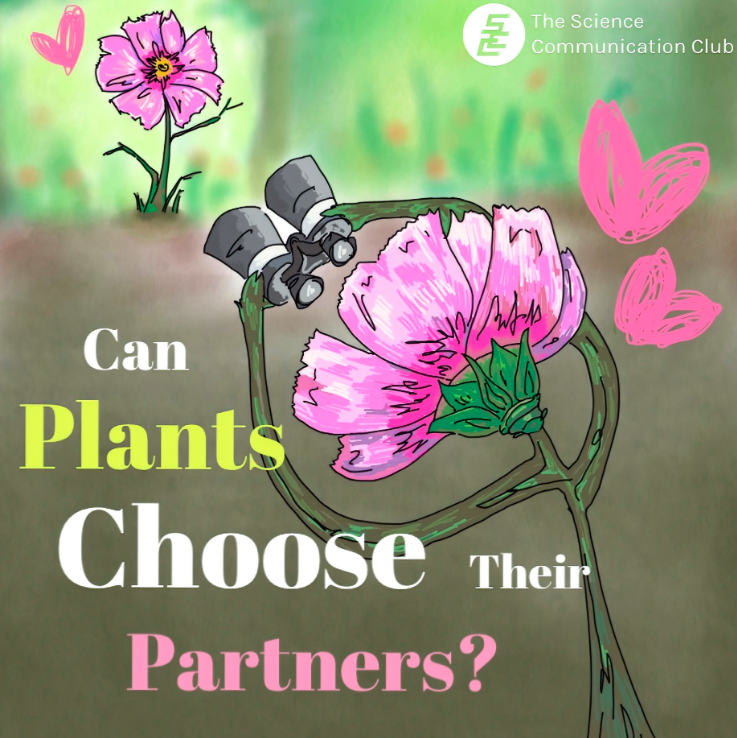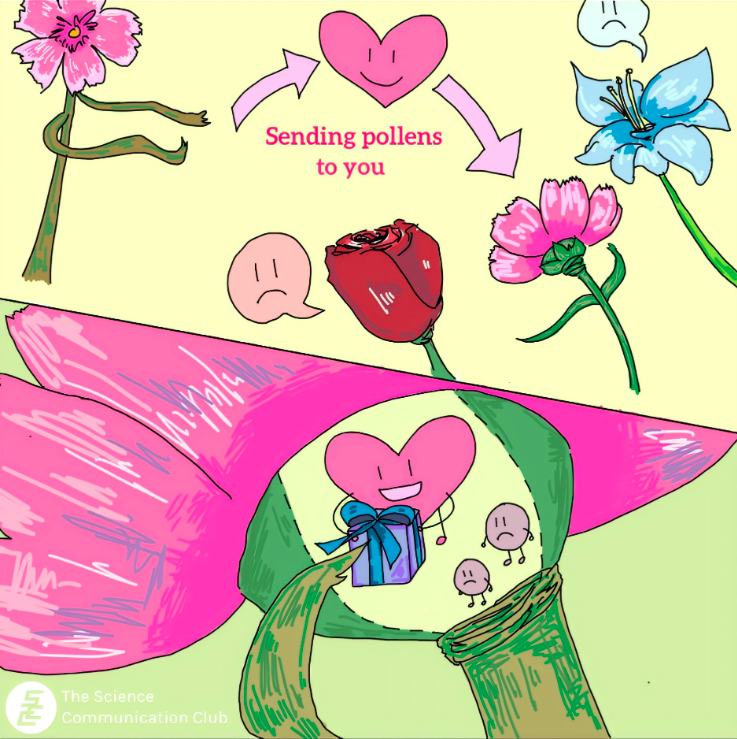
Written by Alejandro Izquierdo Lopez
Illustrated by Haely Oh
This article is part of our Special’s Week series, The Science of Romance.
The life of a plant may look static, uneventful. Plants are photosynthetic: they can produce their own food using CO2 and water, powered by sunlight. But behind their green façade, plants have a more complex, alien lifestyle than we usually give them credit for.
You may be familiar with sunflowers, which follow the Sun’s position, or Mimosa’s leaves, which close after being touched1, or even carnivorous plants, which close their highly modified leaves to trap insects, but these are not isolated cases. Many plants have the ability to respond to their environment, although usually in a much slower pace than animals. Plants, for example, can grow and move in response to the direction of light and gravity2 and even their roots have sensory organs that allow them to detect and grow around obstacles1. Plants communicate with each other through networks of subterraneous fungi (mycorrhizae), which they can use to share nutrients and compounds for multiple roles, even warning about the presence of predators3.
If plants can eat, move and communicate, what else can they do? In the animal kingdom, finding and choosing a partner is a big deal: the antlers of a deer or the plumage of the birds of paradise illustrate the idea that only the best are chosen as partners. If animals can choose, then, can plants choose their partners, as well?
First, we must understand how flowers work. Flowers are a complex reproductive organ with generally four organs: petals and sepals are the exterior “leafy” sections, with different shapes and colours that attract pollinators; the stamens and the pistil are the reproductive organs that produce gametes. Stamens produce pollen: a multicellular, but small structure with a protective capsule that contains gametes. Their role is to travel and fecundate the gametes enclosed in the pistil: the ovules. Most flowers are hermaphroditic4: they produce pollen and ovules, and thus, they can both send and receive gametes. Flowers usually receive more pollen than ovules are available4; not all pollen will be able to fecundate an ovule and form a seed. It is also known that plants highjack pollen coming from their own flowers5 to avoid inbreeding. Based on that, can plants also choose among the different pollen grains they receive? The answer is yes.

From their creation, pollen embarks on a quest, with multiple trial that it has to surpass to finally form a seed. In their first trial, pollen goes on a journey to reach another plant. While many plants just release pollen into the wind, this does not ensure pollen will reach another flower. Attracting pollinators, for example, is usually a great strategy to ensure that this journey is successful. Pollinators can choose which flowers they visit based on their shape5 or colour6, and thus, only the most appealing flowers may be pollinated. This creates a situation in which plants compete to see who gets the highest number of pollinators.
But further trials are still waiting. Now the pollen has reached the stigma, the top of the pistil. There, it needs to germinate and create a structure known as the pollen tube. But germination can be controlled by multiple factors that can be altered by the stigma itself7, including humidity7 or calcium levels8. For example, the stigma may choose to provide only a tiny bit of water, so that only pollen with fewer water requirements germinates9. After germination, the pollen tubes must grow through the style, the “neck” of the pistil. Different pollen tubes “race” through the style to be the first to reach the ovary, where the ovules reside. The pistil, then, becomes a racing track, and its shape and size can influence the final winner10. However, the flower itself can also cheat, and provide more nutrients to its favourite pollen tubes, giving them an edge8.
Finally, a few selected pollen tubes reach the ovaries and fecundate them. You may think that the winners have already been decided, but this is not the case. Once the ovaries have been fecundated, they create small embryos. Embryos, for example, can highjack the growth of their neighbours11, ensuring their growth against their competitors. But the mother flower can still have the final call. Seeds can still be aborted, if not desired; this process is not random, and depends on which plant was the pollen donor5. After the seeds have been formed, the flower transforms into a fruit. However, there is still a final trial, and some fruits may still be aborted, if considered of a lesser quality12.
So, can plants choose their partners? In a sense, they can: pollen has to go through multiple screening processes until it finally creates a fruit. The life of a plant is not as peaceful as it seems: maybe your Ficus at home has a more exciting life that you think.
Sources
- Monshausen GB, Gilroy S. Feeling green: mechanosensing in plants. Trends in Cell Biology. 2009;19(5):228–235. doi:10.1016/j.tcb.2009.02.005
- Molas ML, Kiss JZ. Phototropism and Gravitropism in Plants. In: Advances in Botanical Research. Vol. 49. 2009. p. 1–34. doi:10.1016/S0065-2296(08)00601-0
- Song YY, Ye M, Li C, He X, Zhu-Salzman K, Wang RL, Su YJ, Luo SM, Zeng R Sen. Hijacking common mycorrhizal networks for herbivore-induced defence signal transfer between tomato plants. Scientific Reports. 2014;4. doi:10.1038/srep03915
- Kaul V, Madhu R. Sexual Selection in Angiosperms: Paradox Re-visited. In: Tandon R, Shivanna KR, Koul M, editors. Reproductive Ecology of Flowering Plants: Patterns and Processes. Singapore: Springer Nature; 2020. p. 245–274.
- Christopher DA, Mitchell RJ, Karron JD. Pollination intensity and paternity in flowering plants. Annals of Botany. 2020;125(1):1–9. doi:10.1093/aob/mcz159
- Van Der Kooi CJ, Dyer AG, Kevan PG, Lunau K. Functional significance of the optical properties of flowers for visual signalling. Annals of Botany. 2019;123(2):263–276. doi:10.1093/aob/mcy119
- Marshall DL, Folsom MW. Mate choice in plants: an anatomical to population perspective. Annu. Rev. Ecol. Syst. 1991;22:37–63.
- Shivanna KR. The role of the pistil in screening compatible pollen. Theor Appl Genet. 1985;70:684–686.
- Shivanna KR, Heslop-Harrison J, Heslop-Harrison Y. Heterostyly in Primula. 3, Pollen water economy: a factor in the intramorph-incompatibility response. Protoplasma. 1983;117:175–184.
- Skogsmyr I, Lankinen Å. Potential selection for female choice in Viola tricolor. Evolutionary Ecology Research. 2000;2:965–979.
- Lloyd Mogensen H. Ovule Abortion in Quercus (Fagaceae). American Journal of Botany. 1975;62(2):160–165.12. Stephenson AG, Winsor JA. Lotus corniculatus regulates offspring quality through selective fruit abortion. Evolution. 1986;40(3):453–458.